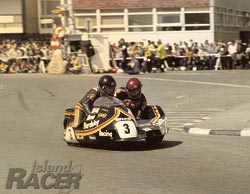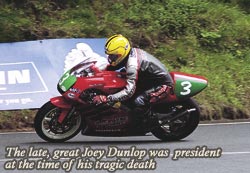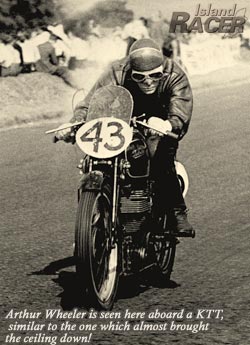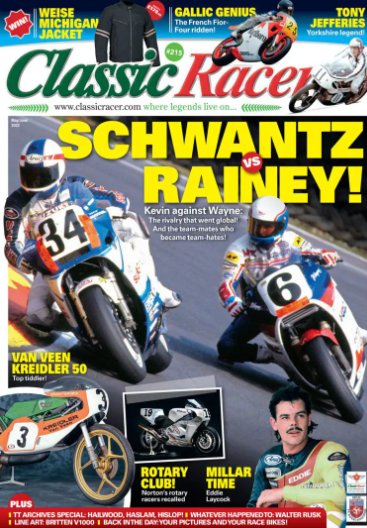T.T.R.A. Origins and History

Proclaimed as the world’s most exclusive club, with membership
restricted to TT racers, the true purpose of the TT Riders’
Association is a mystery to most enthusiasts. It’s a mystery
no more!
 To most TT regulars the sole purpose of the TTRA is to gather together
the aged riders, and equally ancient machinery, that form the now
traditional TT Lap of Honour. Although this living feast of TT history
has great significance, and is the only true opportunity for today’s
enthusiasts to appreciate the pioneers of real road racing, it is
just a small part of what the TTRA is about. The Mountain Circuit
lap and the similar event which takes place at the Ulster Grand
Prix are just the tip of the significant iceberg that is the TT
Riders’ Association.
To most TT regulars the sole purpose of the TTRA is to gather together
the aged riders, and equally ancient machinery, that form the now
traditional TT Lap of Honour. Although this living feast of TT history
has great significance, and is the only true opportunity for today’s
enthusiasts to appreciate the pioneers of real road racing, it is
just a small part of what the TTRA is about. The Mountain Circuit
lap and the similar event which takes place at the Ulster Grand
Prix are just the tip of the significant iceberg that is the TT
Riders’ Association.
The mix of manufacturer-supported riders on works machines and penniless
privateers on homebuilt bikes which you can see at today’s
TT is not new in road racing. It was this unequal struggle that
provided the original inspiration for the TT Riders’ Association.
Way back in the 1940s and 50s, works stars had contract clauses
which included accident insurance, and even funeral expenses. The
rest of the pack spent a year’s salary just to compete in
the world’s greatest road race and they had nothing left for
such cover. Consequentially when things went wrong these events
invariably brought about untold hardship for the riders’ unfortunate
families.
During the 1949 races a rider crashed and was killed. Having no
financial means to return his body home he was buried in a pauper’s
grave, with just a pair of handlebars as a headstone. TT start-line
flagman Rueben Harveyson was so incensed at such an injustice that
he called a riders’ meeting in Belfast later in the year,
and as a result the embryo of the TTRA was formed.
Support from the top men was instant. By 1951 the association was
born and the charity was up and running. The founder members’
list read like a who’s-who of racing. Lincolnshire ace Freddie
Frith was quickly on board, and became the first President, and
he was joined by Alex Bennett, Irish star Stanley Woods, Jimmy Simpson
and others. Membership fees were set at £1 for life and by
the end of the first year donations had been made to the ACU Benevolent
Fund and the Island’s main hospital, Nobles. This ACU donation
was, perhaps, the foundation for the tent, which was made available,
on the suggestion of the ACU’s Ken Shierson, in which riders
and team members gathered after TT practice periods and on race
days.

Amazingly one of the first TT Riders’ to feel the benefit
of the funds collected was Norton star Tim Hunt, who was the first
rider to win two races in a week back in 1931. 30 years later he
had great need of the TTRA.
To this day the aims of the association remain the same. Riders,
and their families, who face real hardship are helped in some small
way. Of course this work goes largely unnoticed. And so it should.
But the sting in the tail for the TTRA is that by hiding its light
under a bushel, the association finds it that much more difficult
to cast the fund-raising net further afield.
In its first year a luncheon was held with just 55 members and guests
sitting down. The luncheon became an annual event, and has grown
in stature such that no one at the first gathering would recognise
the current extravaganza. Now held at the National Motorcycle Museum,
Birmingham, the 2001 luncheon saw over 600 members and guests sit
down together.
 Original
assistant secretary Norman Scott, himself a TT rider in 1921 and
an Irish road racer, eventually took on the treasurer’s role,
and moved the TTRA into serious fund-raising mode. By involving
North of England businessmen Alf Sutton and Bert Warner, and enrolling
them as patrons, serious amounts of money started to be generated.
One of the first things the pair introduced was the auction, which
is now an established part of the post-luncheon activities. Large
amounts are now generated from items of TT memorabilia which have
been generously donated.
Original
assistant secretary Norman Scott, himself a TT rider in 1921 and
an Irish road racer, eventually took on the treasurer’s role,
and moved the TTRA into serious fund-raising mode. By involving
North of England businessmen Alf Sutton and Bert Warner, and enrolling
them as patrons, serious amounts of money started to be generated.
One of the first things the pair introduced was the auction, which
is now an established part of the post-luncheon activities. Large
amounts are now generated from items of TT memorabilia which have
been generously donated.
Although membership of the association itself is restricted to those
who have started in a TT race, it is possible for other enthusiasts
of the Island races to attend the luncheon, by invitation of a member,
and to give something back to those who entertain each year on the
most demanding of courses. And a recent development, The Friends
of the TTRA, has been founded. Using the same principal as Norman
Scott’s patron theory, ‘Friends’ are not former
TT Riders but are influential business people and supporters of
the races who can encourage fund raising from different sources.
Although they have no say in the running of the business of the
Association, the Friends have already proved invaluable when it
comes to generating cash.
All who support the TT do so because they appreciate it is no ordinary
race. It is the Everest of racing.
No event offers either the rider, or the spectator for that matter,
so much satisfaction. But sadly when it bites back it really means
it. In common with all medical facilities, the Island’s Nobles
Hospital is always struggling for funds, and the TT and Manx Grand
Prix races put a tremendous strain on services. For this reason
they have felt the benefit of the TTRA’s funds over the years.
On the spot equipment has been purchased for the helicopter-bound
medical team. I felt the benefit of that helicopter service first-hand,
so I can vouch for its value, as well as hospital-based equipment.
 Just
across the water from the Island, Southport Spinal Unit deals with
the more badly injured from the races, and they too have been supported
in their sterling work. Add to this the (obviously) anonymous assistance
given to injured riders and bereaved families of TT Riders, and
the purchase of marshals’ shelters and seats around the TT
course, and you start to get something of a picture of the value
of the TTRA’s contribution to your annual TT fix.
Just
across the water from the Island, Southport Spinal Unit deals with
the more badly injured from the races, and they too have been supported
in their sterling work. Add to this the (obviously) anonymous assistance
given to injured riders and bereaved families of TT Riders, and
the purchase of marshals’ shelters and seats around the TT
course, and you start to get something of a picture of the value
of the TTRA’s contribution to your annual TT fix.
Don’t get the idea that the TTRA is all about serious business
and no fun. The 1971 President, the late Arthur Wheeler, while basking
in the glow of post-dinner refreshments, came up with the idea of
firing up the KTT Velocette which was on display in the dining room.
He was aided and abetted by the bike’s owner, Ivan Rhodes,
and the resulting din not only almost brought the ceiling down but
proved so popular that it is now an annual event. Recent memorable
occasions have seen wheelchair-bound President Tony Jefferies enter
the dining room aboard a howling Rob North Triumph Triple, with
son David and others waiting to catch him in front of the top table.
The club shares a permanent portacabin base with the Manx Grand
Prix Riders Association behind the Grandstand on the TT course.
This forms a meeting point for some real stars, both past and present,
and if you wish to fill up your autograph book you would do well
to make a beeline for it during this years TT.
| Membership Has Its Privileges |
| If you are a present or former TT rider (or
passenger, of course) and are not already a member of the TTRA
then you can join the T.T.R.A. To find out more, see our CONTACT page. |
And if anyone ever asks you for a donation, well, now you know
who you are giving your money to. Your few quid is going straight
back to help those who have provided you with so much entertainment.

